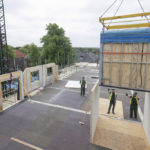Richard Tonkinson, Executive Director of Offsite Solutions, considers the latest innovations in bathroom pod technology and the benefits they offer specifiers.
The use of bathroom pods has increased hugely in recent years. A pod is only pod for the purpose of manufacturing and transportation to site. Once it is installed it is simply a bathroom and is little different from an in-situ built bathroom, aside from an improved quality of fit and finish. The principal function of the pod carcase is to allow fitting out and delivery to site. The carcase is typically either steel-framed or GRP composite, depending on the end use and budget.
Steel-framed pods allow traditional tiled interior finishes and a higher level of design flexibility. Applications include large-scale apartments. GRP pods have lower capital expenditure and are robust and easy to maintain and clean. These pods are widely used for student accommodation, social housing and hospitals.
New innovations in pod technology include hybrid concrete/steel pods for high specification wet rooms; demountable GRP pods for projects with restricted access; and hybrid GRP pods which offer an enhanced finish with options such as recesses and tiled feature walls. Floorless pods can be supplied for projects where a continuous level floor finish is required.
Pods offer significant benefits for projects on constrained urban sites where the space for material storage is a particular challenge. Offsite Solutions for example can supply fully completed bathrooms, delivered to a carefully planned programme for installation in just a few hours — removing the need for additional storage on site and reducing the number of vehicle movements.
One of the key drivers for bathroom pod procurement is to reduce programme times. By moving bathroom construction into a controlled factory environment, the programme saving on a large residential project can be as much as 20 weeks. Site-based bathroom construction typically requires around seven different trades and 10-15 operations plus the required drying times. With offsite manufacture, this is reduced to a single pod supplier, which means less risk of delays and simplified procurement. Bathroom pods also reduce the requirement for skilled labour, site supervision and the associated health and safety obligations.
The production line environment of pod manufacture offers consistently higher quality, and improved productivity. Pre-delivery testing should be rigorous and quality assurance procedures stringent for ready-to-use installation, mitigating defects and remedial works.
How to procure bathroom pods
The most critical consideration for bathroom pod procurement is to engage early. Pods should be designed into the first stages of a construction project and installation must be allowed for in the build-up of walls and floors to reduce the likelihood of access issues. To optimise efficiency, specifiers should rationalise the number of design types in size and shape, and variations, such as left and right-hand versions, as far as possible. This is key to achieving the economies of scale required for efficient offsite manufacture.
When procuring bathroom pods, we would always advise checking:
- Guarantees and accreditations — The manufacturer’s guarantees should be 12 years for steel-framed construction and 50 years for GRP composite pods, with back-to-back guarantees for sanitaryware and fittings.
- Customer service commitments – In-house design resources to advise on materials that perform well in a pod environment; a dedicated site manager who will visit site at regular intervals; and after sales support to advise on any installation issues.
- Quality control — A robust pre-delivery testing regime should be in place — look at the procedures closely. All pods should be certified before delivery to site and supplied with a unique ID number, so they are fully traceable throughout their life for quality control.
- Visit the factory — Look closely at financial stability, figures for repeat business, and project management expertise. Talk to past customers as part of the procurement process.
- Pod construction — Examine the pod construction details to ensure longevity. For example, the entire walls and floor to the wet area of a steel-framed pod should be fully tanked — not just half of the shower wall. GRP pods should have robust wall detailing with encapsulated honeycomb polypropylene. Be aware that cheaper alternatives such as cardboard can be susceptible to delamination.









